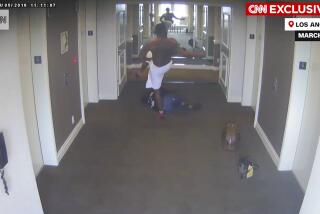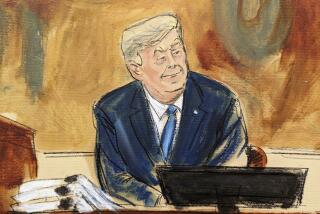Microsoft Video Gaffe May Sink Its Defense
- Share via
WASHINGTON — Microsoft Corp. seriously damaged its chances of winning its antitrust trial, experts say, when it showed a controversial videotape in court this week that was supposed to prove a key point in its defense but instead undermined its credibility.
The video fiasco is the latest in a series of courtroom gaffes that Microsoft has committed in its landmark antitrust battle with the Justice Department, 19 states and the District of Columbia.
In recent weeks, Microsoft Chairman Bill Gates, appearing in court on videotape, and a handful of other company executives and expert witnesses have performed poorly, sometimes drawing derisive comments from an exasperated U.S. District Judge Thomas Penfield Jackson.
“I think Microsoft is doomed,” said James R. Loftis, a veteran Washington antitrust lawyer who is past chairman of the antitrust section of the American Bar Assn.
“This [video snafu] poses a significant problem for them because it permits the judge to make findings as to the credibility and reliability of Microsoft’s witnesses,” Loftis explained. “Those are findings the Court of Appeals will not be able to reverse” should Microsoft lose this round and try to win on appeal, which some observers believe is the company’s long-term strategy.
The pessimistic assessment emerged Thursday as Microsoft showed a new hourlong video in court in hopes of undoing the damage of the previous video, which the government charged did not faithfully reenact a software experiment a Microsoft executive said he had performed on a Windows 98 computer.
Microsoft explained the video, which turned out to be a composite spliced together from several demonstrations, by saying it was intended only as an illustration rather than an actual test.
Though government lawyers did not uncover any new discrepancies in the revised tape Thursday, Microsoft officials admitted in court that the new demonstration does not fully support the company’s claim that removing components of its Internet Explorer Web browser impairs the Windows 98 operating system.
The connection between the Web browser and the operating system is central to the case. The government argues that Microsoft’s practice of combining Internet software with its Windows PC operating system is an illegal act of “tying” one product to another to extend its software monopoly into new markets. Microsoft counters that the Web browser is not a separate product but part of the operating system.
Even before this week’s video incident, the software company was reeling from the fallout caused by the videotaped testimony of Gates.
The usually charismatic software mogul was uncharacteristically hesitant and forgetful on the tape and was criticized by Judge Jackson as “unresponsive” to government questions. The 20-hour testimony was filmed in August and has been played periodically during the 13-week trial.
Gates’ taped performance has been compounded by the live courtroom appearances of Microsoft witnesses, many of whom have wilted on the stand under lead government lawyer David Boies’ cross-examination and made admissions harmful to the company.
Microsoft’s first witness, economist Richard Schmalensee, disavowed some of his own economic claims when Boies confronted him with an article the economist had published earlier in his career that contradicted his stance in this case. “What could I have been thinking?” Schmalensee responded.
Then Paul Maritz, the highest-ranking Microsoft executive called to testify, acknowledged that Microsoft offered financial and business incentives to persuade archrival Netscape Communications Corp. to support Microsoft’s Internet technologies rather than compete by offering an alternative Internet Web-browsing platform.
“From a pure legal standpoint, the video fiasco may not be all that significant by itself, but it comes after Schmalensee” and other witnesses contradicted themselves, said Washington antitrust lawyer Tim O’Rourke. “They [Microsoft] have got to show they can get through at least one witness without getting savaged. This is just terrible.”
“I thought they were in pretty good shape” after the government rested its case in January, said professor Ernest Gellhorn of George Mason University Law School. “But [the video] just destroys their credibility. This suggests that Microsoft hasn’t been forthcoming, that they really may have been trying to divide markets and snuff out competition. They make the Keystone Kops look good.”
Presentation Has Been Weak
Indeed, for all of Microsoft’s wealth and technical savvy, even company officials admit the company has looked like a technological and courtroom neophyte in recent days, conducting its defense much like the plodding ways it develops software.
“I guess you could say this is version one,” Microsoft spokesman Mark Murray observed earlier this week, comparing the ill-fated video to bug-ridden first-generation software. “We’ll have to get it right in version two.”
While the government often put on elaborate courtroom presentations--using a $1,000 multimedia presentation computer program to show exploded views of witness testimony in various colors, for example--Microsoft lawyers until recently relied on a standard overhead projector.
Similarly, while Boies has made flashy surgical strikes to try to discredit Microsoft witnesses by focusing on a few lines of their written testimony, Microsoft lawyers have methodically plodded line by line through the testimony of government witnesses, often losing their main point in the process.
The problematic Microsoft videotape presentation, for instance, was intended to support Senior Vice President James Allchin’s testimony that an Internet Explorer removal program put together by government computer expert Edward Felten degraded the performance of Windows.
Microsoft officials redid the presentation Wednesday night in a demonstration witnessed by government experts. The company played the new 70-minute videotape Thursday, seeking to recoup its credibility.
Microsoft General Counsel William Neukom has maintained throughout the trial that much of the government’s courtroom antics were aimed at the court of public opinion rather than advancing the Justice Department’s legal position.
But Tuesday, after Boies first discredited Microsoft’s video demonstration, Neukom’s actions belied his words.
When the court took a brief recess following Boies’ devastating cross-examination, the normally cool and collected Neukom stood up and doffed his suit jacket, exposing a sweat-drenched shirt.






